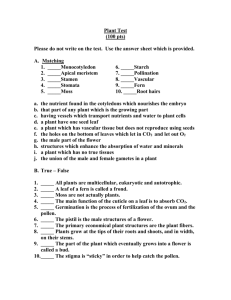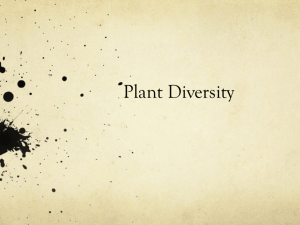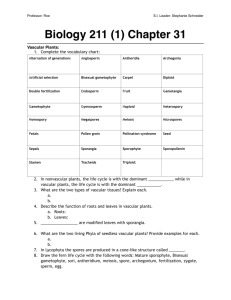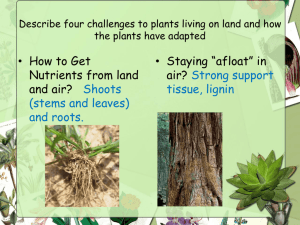Nonvascular Plants
advertisement
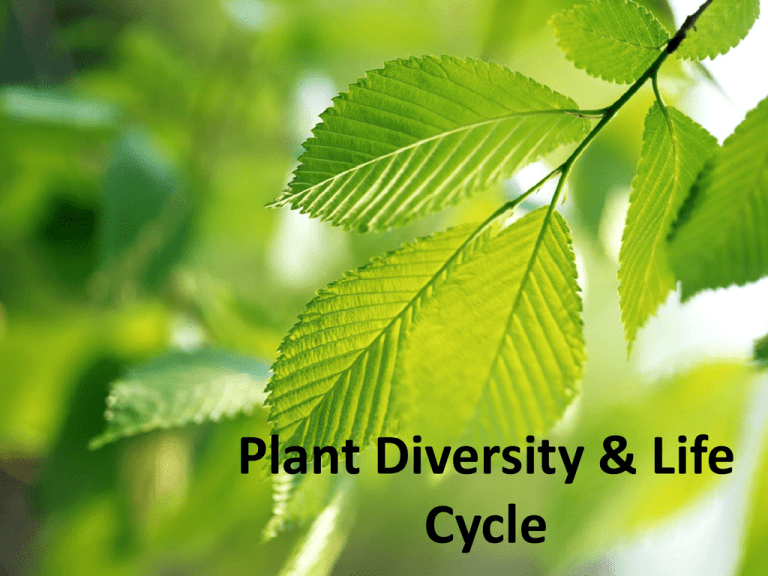
Plant Diversity & Life Cycle Section 1: Intro to Plants I. What is a Plant? A. Basics 1. 2. 3. 4. Multicellular Eukaryotic Autotrophic Cells have cell walls made of cellulose B. Autotrophic 1. Photosynthesis – produces organic compounds (a.k.a. food) using sunlight and CO2 2. Requires Chloroplasts – organelles where photosynthesis takes place II. Establishment of Plants on Land A. Nonvascular Plants – 1st evolved from a multicellular green algae 1. Lack vascular tissue for transporting water & nutrients 2. Grow close to the soil to get moisture B. Vascular Plants – later evolved from a group of nonvascular plants 1. Have vascular tissue for transporting water & nutrients from roots to leaves and organic material back down to the roots. 2. 1st vascular plant was named Cooksonia C. Absorbing Nutrients 1. Early plants lacked roots. Relied on fungi for nutrients from the soil. D. Preventing Water Loss 1. Cuticle – waxy covering that covers leaves & stems to prevent water loss through evaporation 2. Stomata – pores in leaves that allow O2, CO2, & water to move in/out of plant 3. Roots obtain water from soil, replacing water lost to the atmosphere Cuticle Stomata E. Dispersal on Land 1. Spores – early plants produced spores that dried out & were carried by wind 2. Pollen – special type of spore used by seed plants; carries sperm cell 3. Seeds – plant embryo packaged with a food source that can be carried by wind, water, or animals III. Plant Life Cycle *Alternation of Generations A. Plants have 2 stages: 1. Sporophyte Stage – multicellular, diploid stage that produces haploid spores through meiosis 2. Gametophyte Stage – multicellular, haploid stage (a spore grows into this) that produces gametes (sex cells) through mitosis *Plant life cycles alternate between haploid gametophyte & diploid sporophyte. Alternation of Generations Section 2: Seedless Plants *2 Groups of Seedless Plants: Nonvascular & Seedless Vascular I. Nonvascular Plants A. Characteristics 1. Small, short – water transport is through osmosis which only occurs over short distances 2. Reproduce through spores 3. Lack true roots, stems, & leaves – no vascular tissue for transporting water B. 3 Groups of Nonvascular Plants: Bryophytes 1. Mosses • Has cuticle, stomata, & conducting cells • Green, leafy mosses are the haploid gametophyte • A bare stalk with a spore capsule on top is the diploid sporophyte 2. Liverworts • No cuticle, stomata, or conducting cells • Gametophytes are flattened, lobed leaf-like structure • Sporophyte is a short stalk with a spore capsule 3. Hornworts • No conducting cells • Gametophyte is green & flattened • Sporophyte is hornlike & has stomata & cuticle II. Seedless Vascular Plants: Pteridiophytes A. Characteristics 1. Sporophyte is larger because it has vascular tissue & has true roots, stems, & leaves 2. Gametophyte is much smaller as it lacks vascular tissue • Also grows on or under the soil B. 2 Groups of Seedless Vascular Plants 1. Club Mosses • Has roots, stems, & leaves • Rhizome – underground stem; roots grow down from this, while leafy green stems grow up & out of the ground from it. 2. Ferns - what you know of as a fern is the sporophyte • A rhizome is anchored by roots • Leaves are called fronds • Sorus (sori, plural) – cluster of sporangia, structures that produce spores; found on the underside of the fronds • Gametophyte is flat, heart-shaped, & less than 1 cm across (1/2 inch) Fern Gametophyte: Fern Example: Sori: C. Spores of Seedless Vascular Plants 1. Have thickened walls to withstand drying out 2. Easily dispersed by wind 3. Are produced either in cone-like structures or in sori. Section 3: Seed Plants I. 2 Groups of Seed Plants A. Gymnosperms • • Seeds do not develop with in a fruit Most seeds develop inside a cone B. Angiosperms • • • Seeds develop within a fruit Fruits develop from part of a flower Angiosperms are also called flowering plants II. Reproduction is Seed Plants *Greatly reduced gametophyte (microscopic!) & dominant sporophyte A. Basics 1. Sporophytes produce 2 types of spores, each develop into a specific type of gametophyte (male or female) • Female gametophyte develops inside an ovule & produces the female egg. • Male gametophyte develops inside a pollen grain & produces sperm. B. Pollination & Fertilization 1. Pollination – transfer of pollen from male reproductive structure of a plant to the female reproductive structure. • Wind & animals help in dispersing pollen 2. Fertilization – fusion of an egg with a sperm • A pollen tube grows from pollen grain to the female ovule • Sperm can then travel to the ovule & fuse with the egg. C. Seed Formation 1. After fertilization, the ovule develops into a seed. 2. Outer layers of the ovule develop into the seed coat, which protects the embryo inside. 3. Inner layers of the ovule develop into nutrients for the embryo. D. Seed Dispersal 1. Many seeds have structures that help wind, water, or animals carry them away from the parent plant. 2. Dispersal by Wind • wing-like or parachute-like structures carry seeds 3. Dispersal by Animals • Hooks cling to animal fur • Fruits surround seeds, are eaten, and pass undigested through animal’s body III. Gymnosperms A. 4 Groups 1. Conifers • Needle or scale like leaves • Some of the tallest, oldest trees are conifers • Pollen grains disperse by wind 2. Cycads • Short stems, palm-like leaves • Plants are either only male or female • Pollen grains dispersed by insects 3. Ginkgoes • Only 1 living species (maidenhair tree) • Plants are either male or female • Pollen dispersed by wind 4. Gnetophytes • Unique group of trees, shrubs, & vines B. Gymnosperms develop Cones 1. Cones – where gametophytes develop • Are whorls of modified leaves called scales 2. Two types of Cones • Male cones produce pollen grains in sacs under scales • Female cones produce ovules on scales 3. Many plants produce both male & female cones on the same plant, while others only produce one type of cone per plant. Section 4: Flowering Plants I. Kinds of Angiosperms A. Monocots 1. Seeds have 1 cotyledon – embryonic leaf 2. Long, narrow leaves with parallel veins 3. Flower parts are in multiples of 3 B. Dicots 1. Seeds have 2 cotyledons 2. Broader leaves with branching veins 3. Flower parts are in multiples of 4 or 5 II. The Flower A. What is a flower? 1. Specialized reproductive structure 2. Both male and female gametophytes develop within a single flower B. Flower Structures 1. Sepals – small leaves that protect the outside of the flower 2. Petals – colored leaves to attract pollinators 3. Stamen – male part; produces pollen • Anther – top of stamen where pollen is produced • Filament – stalk that supports of the anther Plant Sepals Anther 4. Pistil – female part; produces ovules • Stigma – sticky tip of pistil to grab pollen • Style – stalk that supports stigma • Ovary – base of pistil where ovules develop III. Pollination A. Types of Pollination 1. Self-Fertilization – plant’s pollen can fertilize the same plant’s ovules 2. Cross-Fertilization – plant’s pollen must fertilize ovules from a different plant B. Attracting Pollinators – animals pick up pollen & carry it to another plant 1. Brightly colored petals – bees, birds 2. Sugary nectar 3. Strong odors - bats, moths that feed at night 4. Attractive shapes **Wind can also disperse pollen. IV. Fruits A. What is a fruit? 1. After ovules are fertilized, the ovary of a flower develops into a fruit. 2. Fruits provide some protection for seeds, but function mainly in seed dispersal. B. Seed Dispersal 1. Animals eat the fruits & the seeds pass through the animal undigested as the animals move around. 2. Some fruits have structures that help them float on wind or water. 3. Others forcefully eject their seeds. Exploding Seeds V. Vegetative Reproduction A. Asexual Reproduction 1. Plants can reproduce via stems, roots, and leaves. 2. Reproduction involving these parts is called vegetative reproduction. B. Benefits 1. Much faster 2. A single plant can spread rapidly in an area ideal for its growth C. Examples 1. Tubers (roots) – potatoes, yams, ginger 2. Stems – celery, green onion, asparagus 3. Leaves – lettuce, spinach Section 5: Plant Tissue Systems I. Plant Tissue Types A. Dermal tissue – protective, outer layer of a plant B. Vascular tissue – forms strands that conduct water, minerals, & organic compounds through plant C. Ground tissue – makes up inside of nonwoody plants (roots, stems, leaves) II. Dermal Tissue A. Epidermis – “skin” of nonwoody plants 1. Usually a single layer of cells 2. Can form hair-like extensions • On stems & leaves, hairs trap moisture close to surface to prevent water loss • On root tips, root hairs increase surface area for more absorption B. Cuticle – waxy covering over epidermis 1. Protects plant 2. Prevents water loss by repelling water C. Dermal Tissue of Woody Plants 1. Several layers of cells and is called cork. 2. Contains a waterproof chemical. 3. Lacks a cuticle 4. Protects plant, exchanges gases, & absorbs minerals D. Stomata 1. Cuticle will not allow gases to pass though it, so plants need a way to bring CO2 in and let O2 out. 2. Stomata are pores that permit the exchange of these two gases. 3. Guard cells border each stomata and open/close them. 4. When open, plants gain CO2 but lose water. 5. When closed, plants conserve water, but photosynthesis slows (no CO2). Stomata III. Vascular Tissue System A. Xylem 1. Composed of thick-walled cells that conduct water/minerals from roots through stems to the leaves. 2. At maturity, xylem cells are dead, leaving only cell walls. B. Phloem 1. Composed of cells that conduct sugars &nutrients throughout plant’s body. 2. Cells are alive at maturity, & contain cell walls, cell membrane, & cytoplasm. Cells lack most organelles. IV. Ground Tissue A. Location 1. Found between dermal and vascular tissue. 2. Most abundant in nonwoody plants. 3. Most cells remain alive with thin cell walls and nuclei. 4. Cells with thicker cell walls lose their nuclei & cell contents as they mature (they die ). B. Function depends on location in a plant 1. In leaves, ground cells perform photosynthesis. 2. In stems & roots, ground cells mainly support the plant & store water, sugar, & starch. 3. In angiosperms, ground tissue makes up the flesh of fruits. 4. Ground tissue is mainly absent in woody plants.

